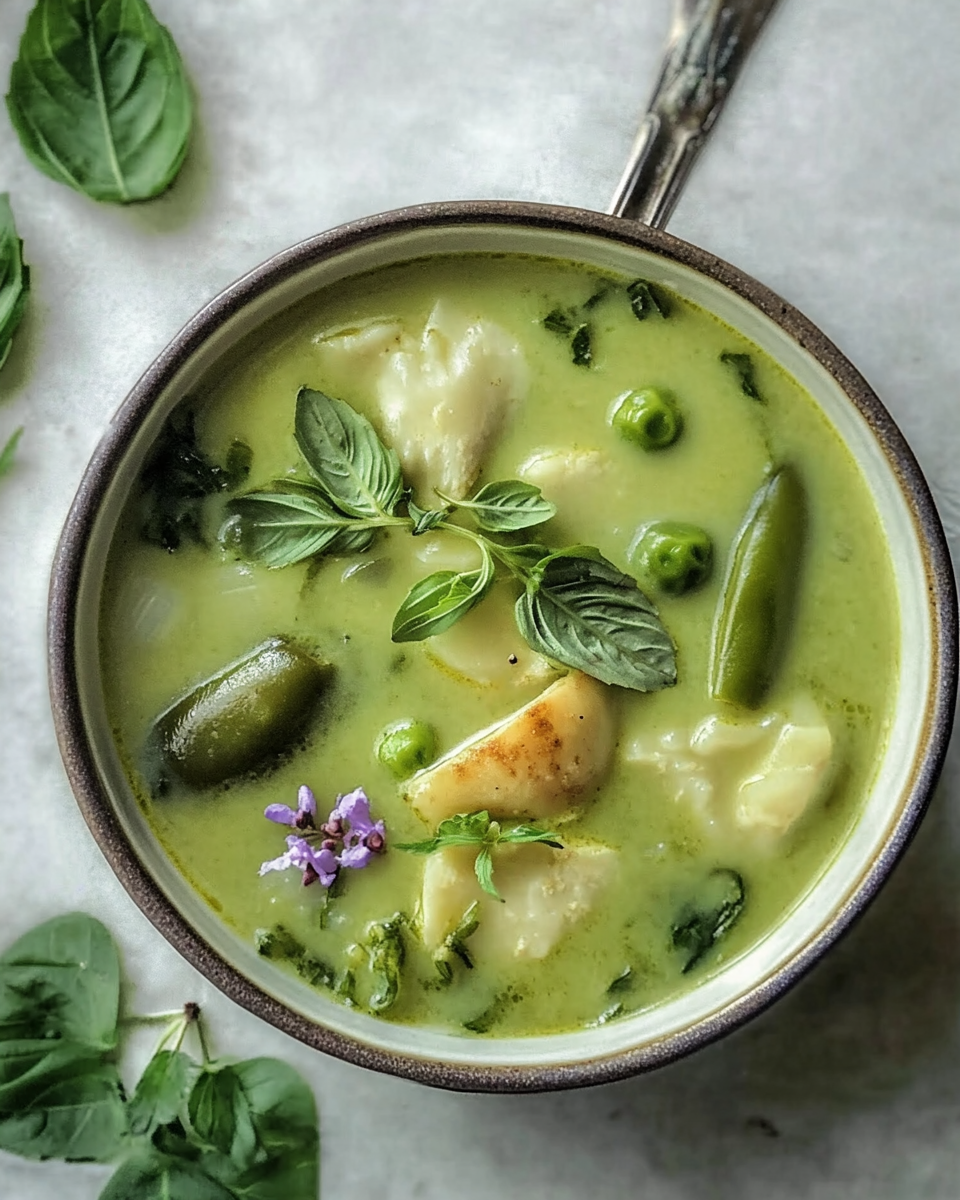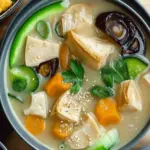Thai Green Curry is a vibrant and aromatic dish that captures the essence of Thai cuisine. Known for its harmonious blend of spicy, sweet, salty, and umami flavors, this curry is both comforting and invigorating. Traditionally made with a fragrant green curry paste and creamy coconut milk, it’s a versatile dish that can be customized with various proteins and vegetables to suit individual preferences. Whether you’re seeking a hearty meal or an introduction to Thai flavors, Thai Green Curry offers a delightful culinary experience.
Full Recipe:
Ingredients
For the Green Curry Paste:
- 5 long green chilies
- 10 green Thai chilies (adjust to taste)
- 5 shallots
- 2 lemongrass stalks
- 11 garlic cloves
- A handful of Thai basil leaves
- A bunch of fresh cilantro
- 2 inches galangal
- 2 kaffir lime leaves
- 1 teaspoon coriander seeds
- 1 teaspoon cumin seeds
- 1 teaspoon white peppercorns
- 1 teaspoon salt
For the Curry:
- 1.5 lbs chicken thighs, boneless and skinless, cut into bite-sized pieces
- 2 tablespoons oil
- 1 can (15 oz) full-fat coconut milk
- 1 cup chicken broth
- 2 tablespoons fish sauce
- 1 tablespoon soy sauce
- 1 tablespoon brown sugar
- 1 tablespoon grated ginger
- 3 garlic cloves, minced
- 1 lemongrass stalk, bruised (optional)
- 1 cup Thai eggplants, halved
- 1 cup bell peppers, sliced
- 1 cup zucchini, sliced
- 1 cup snap peas
- Fresh Thai basil leaves for garnish
Directions
Preparing the Green Curry Paste:
- In a dry skillet, toast the coriander seeds, cumin seeds, and white peppercorns until fragrant. Allow them to cool, then grind them into a powder using a mortar and pestle or spice grinder.
- Chop the lemongrass, galangal, chilies, and shallots into smaller pieces for easier blending.
- In a food processor or blender, combine the chopped ingredients with garlic, Thai basil, cilantro, kaffir lime leaves, and salt. Blend until a coarse paste forms.
- Add the ground spices to the mixture and blend again until a smooth paste is achieved. If necessary, add a splash of water to facilitate blending.
Cooking the Curry:
- Heat oil in a large pan or wok over medium heat. Add the prepared green curry paste and sauté for 2-3 minutes until aromatic.
- Add the chicken pieces to the pan, stirring to coat them with the curry paste. Cook until the chicken is no longer pink on the outside.
- Pour in the coconut milk and chicken broth, stirring to combine. Bring the mixture to a gentle simmer.
- Add fish sauce, soy sauce, brown sugar, grated ginger, minced garlic, and the bruised lemongrass stalk (if using). Stir well.
- Introduce the Thai eggplants, bell peppers, zucchini, and snap peas to the curry. Continue to simmer for 10-15 minutes, or until the vegetables are tender and the chicken is fully cooked.
- Remove the lemongrass stalk before serving.
- Garnish the curry with fresh Thai basil leaves and serve hot with steamed jasmine rice.
Nutritional Facts (Per Serving)
- Calories: Approximately 450 kcal
- Protein: 30 g
- Fat: 30 g
- Saturated Fat: 20 g
- Carbohydrates: 15 g
- Sugar: 5 g
- Fiber: 3 g
- Sodium: 900 mg
Cultural Significance of Thai Green Curry
Green curry, or “Gaeng Keow Wan” in Thai, holds a special place in Thailand’s culinary heritage. Unlike red or yellow curries, which are also popular, green curry is known for its fresh and sharp flavor profile. The “green” in green curry comes from the abundance of fresh green chilies and herbs used in the curry paste. It reflects the Thai culinary philosophy of using fresh ingredients to create bold and complex flavors. Historically, curry pastes in Thailand were handmade in households, varying by region and family recipes, which gives each preparation a unique taste. This dish is a common choice for family meals, special occasions, and is often enjoyed across different social settings in Thailand.
Flavor Profile and Ingredients’ Role
The distinct flavor of Thai Green Curry is a result of the delicate interplay between its key ingredients. The green curry paste is made by pounding fresh green chilies with aromatic herbs such as lemongrass, galangal, kaffir lime leaves, garlic, and shallots. These ingredients bring freshness and a slight citrusy note to the curry. The use of coconut milk balances the heat from the chilies with its creamy sweetness, producing a rich, velvety texture. Fish sauce and soy sauce introduce a deep umami flavor and salty notes, while palm or brown sugar adds a subtle sweetness that harmonizes the dish. The addition of fresh vegetables like Thai eggplants, bell peppers, zucchini, and snap peas introduces texture and visual appeal.
Versatility of Thai Green Curry
One of the reasons Thai Green Curry is so popular worldwide is its incredible versatility. Traditionally made with chicken, it also adapts well to other proteins such as beef, pork, seafood, or tofu for vegetarian options. This flexibility makes it suitable for a variety of dietary preferences and occasions. Vegetables can also be swapped or added depending on what is in season or personal preference. This adaptability has helped the dish transcend cultural boundaries and become a beloved meal in many countries, often featured in Thai restaurants globally.
Health Benefits and Nutritional Aspects
Thai Green Curry is not just flavorful; it can be a nutritious addition to your diet when prepared mindfully. Coconut milk, while rich in saturated fat, contains medium-chain triglycerides (MCTs) which may have health benefits such as boosting metabolism and providing quick energy. The inclusion of fresh vegetables adds fiber, vitamins, and antioxidants, which contribute to overall health. Spices like turmeric, lemongrass, and galangal used in the curry paste have anti-inflammatory and immune-boosting properties. However, the dish can be high in sodium due to fish sauce and soy sauce, so it’s important to balance these or choose low-sodium alternatives if needed. The protein content in chicken or other meats supports muscle health and satiety.
Preparation Techniques and Culinary Tips
Creating an authentic Thai Green Curry requires some specific culinary techniques and attention to detail. Traditionally, the curry paste is made fresh by pounding the ingredients in a mortar and pestle, which helps release the essential oils and flavors in a way that pre-made pastes cannot match. When cooking, it’s important to fry the curry paste in oil first to intensify its aroma before adding liquids like coconut milk. This step unlocks deeper layers of flavor. Simmering the curry gently allows the flavors to meld without overcooking the vegetables or protein. Adding fresh herbs like Thai basil at the end enhances the freshness of the dish. Serving it immediately with steamed jasmine rice completes the authentic dining experience.
Global Popularity and Adaptations
While Thai Green Curry originates from Thailand, its global appeal has led to numerous adaptations. In Western countries, for example, coconut milk is often replaced or diluted with lighter cream to reduce fat content. Vegetables might be substituted with more familiar options, and spice levels adjusted for different palates. Many restaurants offer milder versions to accommodate those who prefer less heat. Despite these changes, the fundamental elements of the dish — aromatic curry paste, creamy coconut milk, and fresh herbs — remain central to its identity. This adaptability is a testament to the dish’s robustness and enduring appeal.
Serving Suggestions and Pairings
Thai Green Curry is typically served hot with jasmine rice, which helps soak up the rich, flavorful sauce. Some prefer sticky rice, which is a staple in northeastern Thailand. It can also be complemented with side dishes like Thai cucumber salad or fresh spring rolls to add contrast in texture and flavor. A light, refreshing drink such as iced Thai tea or coconut water pairs well to balance the spiciness and richness of the curry. Garnishing with fresh herbs like Thai basil or cilantro not only adds a burst of color but also intensifies the aroma and freshness of the meal.
Conclusion
Thai Green Curry is more than just a dish — it’s an experience of Thai culture, tradition, and the artistry of balancing complex flavors. Its vibrant green color and the aromatic blend of fresh herbs and spices create a sensory delight that appeals to food lovers around the world. The dish’s versatility makes it accessible to a wide range of dietary needs and preferences, while its nutritional benefits offer a wholesome option for a satisfying meal.






